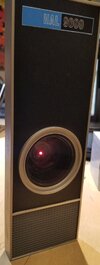I was starting to feel guilty about all my chatter about my own build in other people's threads so I figured I should start my own thread.
This all snowballed for me after I accidentally stumbled upon some replica HAL lenses for sale on eBay and then got curious about building a HAL 9000 replica.
As I weighed the thought of buying the lenses I started to research the Moebius models HAL 9000 kit that I'd never heard of before and were referenced in the lenses product description. Building a super realistic HAL 9000 suddenly seemed in reach.
Then I remembered that my best friend is a huge 2001 fan and thought "
Hmm this might make a good gift idea for him." which then turned into "
I should buy two of each so I can build one for him, and one for myself!"
So I bit the bullet and bought
two of the replica lenses off eBay (Now sold out) and
two of the Moebius kits off of Amazon.
Then I discovered other people's HAL 900 builds here on RPF.
I looked at what other people had done and then decided that maybe the plastic kit wasn't good enough and maybe I should replace much of the kit with upgraded parts (including metal)
Related threads I've participated in so far:
I'm still early in my build and moving slowly but my plan is for one of the following options:
- Build the kit as-is (painted plastic) with the replacement lens. (Not likely at this point.)
- Upgrade the kit with a new faceplate that is either:
- Vinyl wrapped polystyrene in a brushed anodized black aluminum finish (I've ordered and receieved the vinyl and it's "ok".)
- Actual metal brushed anodized black aluminum finish. (I've order a plate and it's enroute to me now.)
- Upgrade the kit with a new faceplate AND an aluminum frame, AND custom machined aluminum lens enclosure rings. (I have requests for quotes in progress.)
Regardless of what option I go with, the build will also have sound effects built in. I'm currently getting a quote from an Arduino expert on Fiverr who may be building it for me. Unlike most HAL 9000 builds though, mine would be triggered with a small remote to play the sounds as opposed to a physical button on HAL. The question is where to place the remote sensor? (In the speaker grill?, hidden inside the lens? We'll see.)
This evening I meticulously cut apart the Moebius plastic lens ring to accomodate the glass replacement lens and it went extremely well but it still needs more sanding. The glass lens fits into the original part extremely snugly and definitely won't be falling loose as I had initially feared.
More to come soon. This thread will be peppered with pics.

